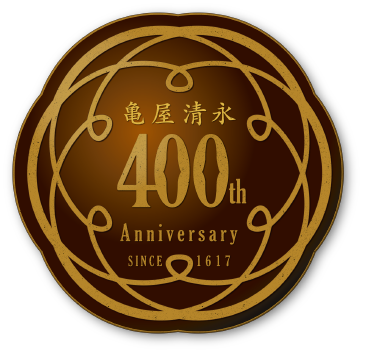The history of Kameyakiyonaga.
The roots of Kyo-gashi (Kyoto-style Kashi).
The history of Kyo-gashi is also the history of treats in Japan. Kashi (treats) originally meant fruits. According to a legend, Tajimamori brought a fruit from Tokoyo-no-kuni (between China and India) as “the elixir of life” for 11th Ten-nou (Japanese king). It took nine years for him to deliver the fruit, Tokijikuno-kakuno-konomi, and this became the origin of Kashi.
In the Nara period, Buddhism was brought from China. At the same time, Chinese Kashi, “Kara-kudamono” was brought to Japan. The Kashi was made with grains, such as rice, wheat and beans. Our representative Kashi, Seijou-kankidan is one of them. Kara-kudamono is also the origin of Kyo-gashi.
Kara-kudamono are fried dumplings or rice cakes with salt. People used them for an offering or a noble banquet. They are ritual Kashi and we still use them as offerings for shrines and temples.
 Nameplates of shrines and temples where we supply our treats.
Nameplates of shrines and temples where we supply our treats.
 Wood molds for dried confectionaries, exclusively used for shrines and temples
Wood molds for dried confectionaries, exclusively used for shrines and temples
Kyo-gashi prospered in the Edo period.
In the Nara period, sugar was also brought from China. A Chinese monk, Ganjin gave Sekimitsu (called the origin of sugar) as a medicine to Ten-nou and this was the start of sugar in Japan. At this time, only the nobles and generals were able to have sugar.
In the middle of 16th century, missionaries from Portugal and Spain brought Nanban-gashi (the South Sea countries’ treats), such as Boro (small round cookie), confetti, Kasutera (sponge cake) and Aruhei-tou (sugar candy). After this, people started using sugar for making Kashi and the taste was getting sweet. In the Adzuchi-momoyama period, the tea ceremony was made popular by Sen-no-rikyu and it had a big influence on the development of Kashi. In the Edo period, the culture of townspeople reached its peak and Kashi rapidly developed as well, symbolizing the affluent period. The name, “Kyo-gashi,” was made around this time.
 An old book named “Kyo-habutae” published in 1685. It was a guide book to the sights in Kyoto.
An old book named “Kyo-habutae” published in 1685. It was a guide book to the sights in Kyoto.
 Various kinds of shop names are written in “Kyo-habutae”. “Kameyakiyonaga” is mentioned as the top of the list of pastry shops.
Various kinds of shop names are written in “Kyo-habutae”. “Kameyakiyonaga” is mentioned as the top of the list of pastry shops.

 “Gosho-makimono,” a menu of Kashi, which Kameyakiyonaga supplied to the Kyoto Imperial Palace in 1842. It has names of Kashi and prices at that time.
“Gosho-makimono,” a menu of Kashi, which Kameyakiyonaga supplied to the Kyoto Imperial Palace in 1842. It has names of Kashi and prices at that time.
Kameyakiyonaga became the Purveyor to the Royal Household “Kyo-gashi-shi”.
Kameyakiyonaga was established 1617 and was situated on the north side of Teramachi-sanjo. The store name was “Kameyajihei,” but was later renamed to “Kameyakiyonaga”.
In 1857, the Edo shogunate (government) limited the number of Jo-gashi-shi (high qualified pastry shop) to 248 shops to keep up the quality of Kyo-gashi. The number of pastry shops to be the Purveyor to the Royal Household were also limited to only 28 shops. After this, people started considering Kyoto to be the center of Kashi.
Moreover, the 28 pastry shops were called “Kyo-gashi-shi” and Kameyakiyonaga was one of them.
Kameyakiyonaga had special permission to enter places such as the ancient Imperial Palace, various city states, temples and shrines in Japan. After that, thanks to the efforts of those generations, we received the title of “Izumi-no-daijo”. Responding to the changes of the Meiji Restoration, we stopped using the title and went back to the original name, “Kameyakiyonaga”. We still maintain the pride and tradition of Kyo-gashi-shi and take efforts to develop Kyo-gashi.
 A Kashi container, Hokai. People put Kashi in it and brought it to the Kyoto Imperial Palace, shrines, temples and so on. The sides have turtle patterns decorated with lacquer, golden powders, silver powders and thin shells.
A Kashi container, Hokai. People put Kashi in it and brought it to the Kyoto Imperial Palace, shrines, temples and so on. The sides have turtle patterns decorated with lacquer, golden powders, silver powders and thin shells.
 A lacquered box with a beautiful turtle pattern. Usage and age are unknown, but you can imagine that it was used for bringing Kashi or a gift.
A lacquered box with a beautiful turtle pattern. Usage and age are unknown, but you can imagine that it was used for bringing Kashi or a gift.



